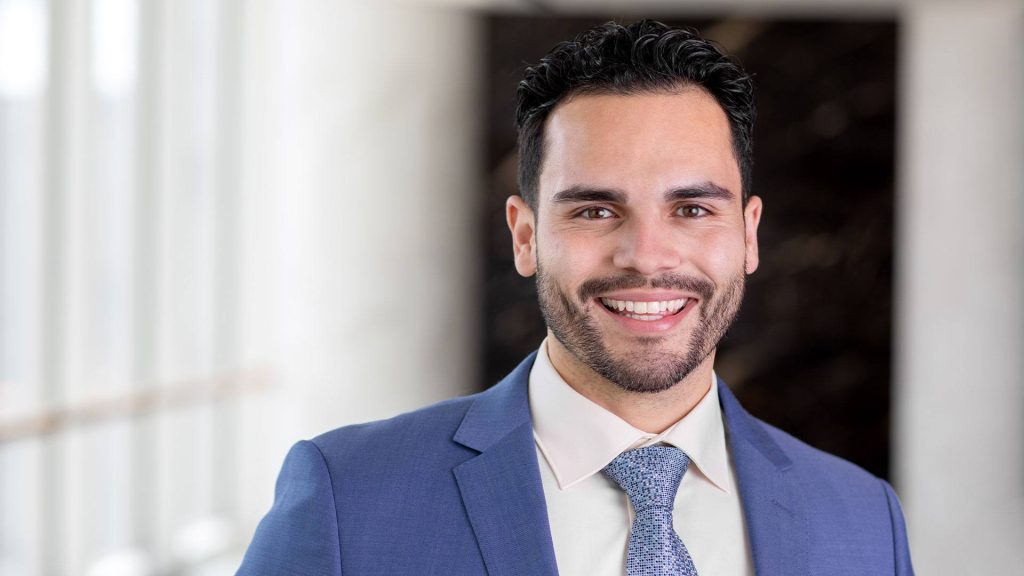-
Biotherapeutics
Regenerative biotherapeutics trainee comes full circle

During his medical training, Joshua Romero, M.D., often heard about regenerative medicine and how researchers were using biologics — such as cells, proteins, and even genes — in an attempt to heal damaged tissues and organs. But it wasn't until he did an elective in regenerative medicine as a resident during his intern year at Mayo Clinic School of Graduate Medical Education that he began to grasp the promise of this emerging field.
"I saw that there was a lot of new research in this area, so it was clearly an area that's still developing," he says. "And I noticed it was a niche area that not many people have expertise in. So I think that understanding this topic at a deep level could set you apart from others."
Dr. Romero's path to medicine was relatively unconventional. He grew up in Albuquerque, New Mexico, where he credits football with keeping him out of trouble. He played linebacker for the University of New Mexico and was the first in his family to go to college. "I believe if it weren’t for sports, I wouldn’t be where I am today — I’d be on a very different path," he says.
With all his exposure to athletics, he thought about being a strength and conditioning coach, and then began to consider a career in sports medicine. "I wasn't sure I could get into medical school, and I wasn't sure I could get through it. I didn’t truly believe in myself, but I still chased it regardless," he says.
Even after he excelled in medical school and landed a highly coveted residency position at Mayo Clinic in Rochester, Dr. Romero still dealt with imposter syndrome. With support from his mentors and numerous opportunities for growth, he realized he belongs at Mayo Clinic, which he now proudly calls home.
"I feel like Mayo Clinic really shaped me into being a very competent and very compassionate physician, which is what I always wanted to be," he says.
Through his elective in regenerative medicine, Dr. Romero gained a bigger picture of the prospects and challenges of this new type of medical care. "I saw that there's a lot more beyond the science — there's the manufacturing and understanding what can and cannot occur from a regulation standpoint," he says. "There are a lot of moving parts to make it possible for us to offer these therapies to patients."
Carrie Thompson, M.D., the internal medicine residency program director at Mayo Clinic School of Graduate Medical Education, says there is "a significant gap in current healthcare education when it comes to regenerative medicine" that her program aims to help fill. "Through this elective, we have trained over 100 residents, preparing them to lead the way in this rapidly evolving field," she says.
At the 2023 American Medical Society for Sports Medicine (AMSSM) Annual Meeting, Dr. Romero was one of only a few trainees selected to give an oral presentation on his research during a special pre-conference session. This work described how injections of platelet-rich plasma (PRP) — concentrated platelets derived from a patient's own blood — are a durable treatment for plantar fasciitis, improving pain and function over the long term.
Dr. Romero contributed to a chapter on PRP for a textbook specifically focused on a branch of regenerative medicine known as orthobiologics, which addresses orthopedic issues with biologic treatments. He is also helping AMSSM develop a curriculum on orthobiologics for sports medicine fellows nationwide.
Recently, Dr. Romero has developed a particular interest in a type of orthobiologic treatment known as shockwave therapy, which uses high-energy acoustic waves to promote tissue repair and regeneration. His goal is to create a shockwave clinic that provides this therapy for athletes during their competitive seasons or people who are trying to return to physical activity.
"Investing in next-generation workforce development is essential to bring these breakthrough biotherapies into clinical practice," says Saranya Wyles, M.D., Ph.D., associate director for education at the Center for Regenerative Biotherapeutics. "Mayo Clinic is proud to be at the forefront of this transformative effort."
In June, Dr. Romero completed his fellowship in sports medicine at Mayo and now is helping with the fellowship as the associate program director. He is one of the team physicians for the local community college, where he covers athletics after hours. He is frequently joined on the sidelines by medical students or residents eager to learn the tricks of the sports medicine trade.
"Whenever someone asks about electives, or wants to know if they can shadow me, I'm happy to have them," he says. "Because you never know when a few hours of your time, or a few positive words, can change someone's career trajectory."
Looking back, Dr. Romero says he feels very fortunate to have ended up where he is.
"I think Mayo Clinic enabled me to foster a passion in regenerative biotherapeutics, and also helped me achieve a position where I am contributing to the field at a national level. That all started with an elective, continued through mentorship and training, and now, as a staff member. What started as just an interest has become a big part of what I do day to day," he says.







